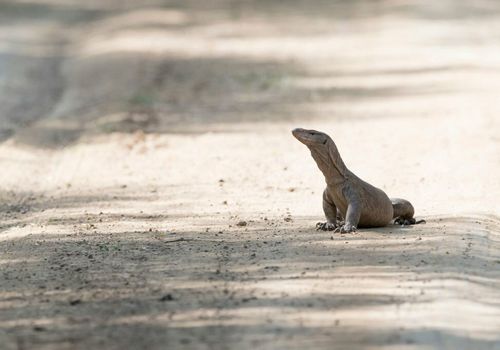Ranthambore National Park
Rajasthan, India
About Ranthambore National Park
Rajasthan, a globally renowned Indian state, is celebrated for its opulent cultural heritage, replete with a history teeming with customs, royalty, vibrant fairs, and festivals. This same opulence and timelessness are echoed in another of its natural treasures, the Ranthambore National Park.
Ranthambore National Park stands as one of India’s largest and most distinguished national parks, drawing throngs of visitors due to its remarkable biodiversity. It’s nestled amidst the ancient geological wonders of India, nestled between the Aravallis and the Vindhya range. Covering a vast expanse of 515 square miles, with 151 square miles designated as wildlife reserves, the park is a testament to the country’s natural splendor.
One of the main attractions within the park is the Ranthambore tiger safari, Over the years, these majestic tigers have grown accustomed to human presence and are known to be active during daylight hours, making them easily visible. Given that tigers are one of the most photographed wild animal species, Ranthambore is an ideal destination for captivating tiger safari adventures.
Highlights
- Rich cultural heritage and history
- Abundant flora and fauna
- Stunning natural beauty
- Between Aravalis and Vindhya
- 515 sq. miles area
- 151 sq. miles wildlife reserves
- Diurnal tigers for easy spotting
- Ideal for tiger safari tours
For those seeking immersive experiences beyond the tiger safari, Ranthambore offers a plethora of opportunities such as nature safaris in India, providing a chance to witness the diverse flora and fauna that thrive within the park. Bird enthusiasts can indulge in the thrill of bird-watching in India, as Ranthambore is home to a vibrant avian population.
For a comprehensive exploration of India’s wildlife and cultural heritage, visitors can embark on specialized tours, such as tiger safari and Taj Mahal tours. This unique combination allows travelers to witness the grandeur of both nature and architectural marvels, creating a well-rounded Indian experience.
Ranthambore National Park is not only a habitat for tigers but also houses other fascinating species like leopards, sloth bears, and more. Travelers can opt for themed tours such as **tiger and leopards safaris** to delve into the diverse wildlife that calls this park home.
Moreover, for those yearning to merge wildlife adventures with cultural immersion, tailor-made tours like tiger and culture tours are available. These tours provide a balanced exploration of the region’s rich cultural heritage alongside the captivating wildlife experiences in Ranthambore.
In essence, Ranthambore National Park transcends the boundaries of a typical wildlife destination, offering a tapestry of experiences that weave together nature, culture, and the majestic presence of the Bengal tiger. Whether one is seeking the thrill of a tiger safari or a holistic exploration of India’s natural and cultural wonders, Ranthambore stands as an unrivaled destination.
Ranthambore is a place where tiger sightings are quite common, and some of these majestic creatures have even achieved celebrity status, featuring in their own TV shows and appearing in numerous documentaries. The landscape of this region is truly unique, offering deep gorges, rugged hills, grassy slopes, ravines, and expansive lakes, making it a paradise for photographers. Nestled between the Chambal River and Banas River, Ranthambore National Park is more than just your typical safari destination. It’s an ideal vacation spot where tourists can indulge in various activities, such as trekking to explore the grandeur of Ranthambore Fort, visiting the ancient temples, admiring the ruins of Raj Bagh, and exploring Jogi Mahal. All in all, Ranthambore provides a fantastic backdrop for your first encounter with these magnificent tigers!
Facts about Ranthambore National Park
Area: 1334 sq. km.
Coordinates: Latitude: 26° 01’ 02” N, Longitude: 76° 30′ 09”E.
Key Species of Ranthambore National Park

Mammals
- Tiger
- Sloth Bear
- Jungle Cat
- Leopard
- Caracal
- Honey Badger
- Rhesus Macaque
- Gray Langur
- Spotted Deer
- Sambar

Birds
- Indian Grey Hornbill
- Oriental Honey Buzzard
- Rufous Treepie
- Black Headed Ibis
- Indian Peafowl
- Golden Oriole
- Jungle Owlet
- Painted Spurfowl
- Indian Pitta
- Black Rumped Flameback

Reptiles
- Bengal Monitor Lizard
- Saw Scaled Viper
- Indian Rock Python
- Marsh Crocodile
- Russell’s Viper
- Wolf Snake
- Indian Chameleon
- Green Keelback
- Indian Flapshell Turtle
- Spectacled Cobra
Safari Zones of Ranthambore National Park
National Parks typically consist of three types of zones: Core, Buffer, and Reserved. The core zone serves as a protected jungle area, preserving the natural state of the ecosystems within biosphere reserves. The forest department strictly safeguards wildlife and natural resources in this region. In the buffer zone, animals and a portion of human settlements coexist harmoniously. Meanwhile, the reserved forest acts as a virtual boundary for the park.
It’s important to note that animals within these parks are not aware of these designated zones and roam freely throughout the entire forest, which is their natural habitat.
Ranthambore National Park is a unique case, as it uses numbered zones rather than names. Initially, it had only five zones, but due to increasing popularity and attention from wildlife enthusiasts, the park expanded to accommodate ten zones. Each of these ten zones boasts a rich variety of flora and fauna. When embarking on a safari in Ranthambore National Park, be sure to inquire with your guide about exploring these zones to their fullest. Here’s a breakdown of how the zones are distributed.
Zone 1: Sultan ( T-72 ), Noor (T-39) with Two Cubs Ustad (T-24)
Zone 2: Krishna (T-19) with Three Cubs, Gayatri (T-22), Ustad (T-24), Noon (T-39) with Two Cubs Sultan (T-72), Jhumru (T-20)
Zone 3: Star Male (T-28), Krishna (T-19), Three Cubs of Krishna (T-19)
Zone 4: Machli (T-16), Bhola/Dollar Male (T-25), Krisha (T-19) with Three Cubs, Star Male (T-28), Romeo (T-6), Mr. Bond (T-47), Laila (T-41) with one cub
Zone 5: Romeo (T-6), Two Cubs of Sunehari (T-17), Bhola/Dollar Male (T-25), Bhadur (T-3), Laila (T-41) with one cub
Zone 6: Ustad (T-24), Kumbha (T-34), Sultan (T-72), Noor (T-39) with Two Cubs
Zone 7: Ladli (T-8) With Two Cub, Kumbha (T-34)
Zone 8: Ladli (T-8) With Two Cub, Kumbha (T-34)
Zone 9: Ladli (T-8) With Two Cub, Kumbha (T-34)
Zone 10: Zone 10- T-42(Fateh, Male Tiger), T-13(Old Sultanpur Female) & her three 6 months old Cubs
Reaching Kanha National Park
Train
The closest rail head to the park is Sawai Madhopur at a mere distance of 11 kms from the park, followed by Kota and Jaipur at a distance of 108 and 180 kms.
Flight
The closest Airport is the Jaipur, which is at a distance of 180 kms from the park. Jaipur has great connectivity with major cities in the country including New Delhi, Mumbai, Kolkata, Hyderabad etc.
Road
Ranthambore National Park is accessible by road from most of the major cities in India by busses or private cabs.
New Delhi – Ranthambhore: 381 kms (06-hour drive)
Jaipur – Ranthambhore: 180 kms (03-hour drive)
Agra – Ranthambhore: 239 kms (05-hour drive)
Bharatpur – Ranthambhore: 202 kms (04-hour drive)
Weather and Clothing
- DO NOT carry shiny/bright colored clothing. Instead, carry earthy colors like shades of dull green or olive green, beige, and grey. Black is also avoidable as it attracts mosquitos.
- Carry comfortable, breathable clothes (cotton) in summer.
- Carry layers (4-5) of thin woolen clothes rather than one heavy jacket for winter. Layers are a lot more helpful through the varying temperatures during the day.
- Carry a wind cheater/rain coat just in case there is a light shower.
- Carry a Cap/Hat during summer.
- Avoid wearing strong perfume while on safari. Animals have a strong sense of smell and it may distract them.

Enquire Now
Please fill the form below and our team will get back to you within 24 hours with a perfect tiger safari tour package.
FAQ
Ranthambore National Park is one of the most renowned national parks in India, situated in the northwestern state of Rajasthan. It is known for its remarkable wildlife and is particularly famous for its population of Bengal tigers.
You can reach Ranthambore National Park by air, train, or road. The nearest airport is Sanganer Airport in Jaipur, which is around 180 kilometers away. Sawai Madhopur Junction is the closest railway station, and it’s well-connected to major cities. The park is also accessible by road from nearby towns and cities.
The best time to visit Ranthambore National Park is from October to June. The park is closed during the monsoon season (July to September). The peak wildlife viewing season is from November to April when the weather is pleasant, and the vegetation is less dense.
A tiger safari in Ranthambore offers a thrilling opportunity to spot Bengal tigers in their natural habitat. The park is home to a significant population of these majestic creatures, and your safari experience may also include sightings of various other wildlife species, such as leopards, sloth bears, and a diverse array of bird species
Yes, Ranthambore is divided into different zones, and each zone offers a unique wildlife experience. Some zones are particularly well-known for tiger sightings, like Zone 2 and Zone 6, while others offer diverse flora and fauna encounters.
To embark on a tiger safari in Ranthambore, you need to obtain the necessary permits and follow park regulations. You can secure these permits through the official website or at the park’s booking office. Be sure to adhere to the rules and guidelines for wildlife conservation and safety during your safari.
No, exploring the park on foot is not allowed to ensure the safety of visitors and the wildlife. Safaris are conducted in open-top vehicles, and you must be accompanied by a certified guide.
Yes, there are several accommodations available near the park, ranging from luxury resorts to budget-friendly options. Staying in these accommodations allows you to enjoy the serene surroundings and easy access to the park.
Ranthambore is not only famous for its wildlife but also boasts historical and cultural attractions. The Ranthambore Fort, a UNESCO World Heritage Site, is a significant historical landmark in the region, and there are nearby temples and lakes to explore.
You can support tiger conservation efforts by being a responsible visitor, respecting park rules, and promoting awareness about the importance of preserving these majestic creatures and their habitat. Additionally, consider contributing to organizations dedicated to tiger conservation in India. Your support can help ensure the survival of tigers in Ranthambore and other national parks in the country.



